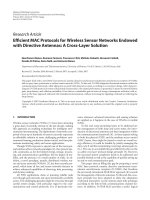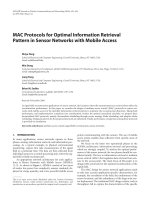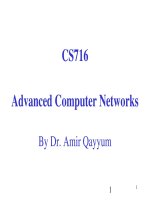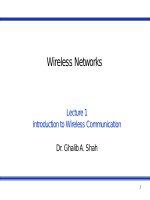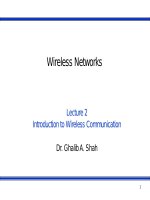Wireless networks - Lecture 35: MAC protocols for WSN
Bạn đang xem bản rút gọn của tài liệu. Xem và tải ngay bản đầy đủ của tài liệu tại đây (711.99 KB, 29 trang )
Wireless Networks
Lecture 35
MAC Protocols for WSN Part II
Dr. Ghalib A. Shah
1
Outlines
Challenges in WSNs.
Attributes of MAC Protocol
Overview of MAC protocols
Energy Efficiency in MAC
Proposed Routing Protocol
►
►
►
►
►
►
S-MAC
T-MAC
DS-MAC
Traffic Adaptive MAC
DMAC
Contention-Free MAC
2
Last Lecture
Introduction to WSN
Applications of WSN
Factors Influencing Performance of WSN
► Power consumption, fault tolerance, scalability, topology,
cost
Architecture and Communication Protocols
3
Research Directions
Topology Control
Coverage
Data Aggregation
Temporal/Spatial Correlation
Localization / Synchronization
Energy Efficient Data Dissemination
QoS Framework
Network Monitoring and Management
How to integrate WSNs into NGWI ?
4
Simulation for Sensor Networks
Simulation provides :
Controlled , Reproducible testing environment
Cost – effective alternative
Means to explore and improve design space
5
TinyOS
The role of any operating system (OS) is to promote
development of reliable application software by
providing a convenient and safe abstraction of
hardware resources.
Wireless sensor networks (WSNs) are embedded but
general-purpose, supporting a variety of applications,
incorporating heterogeneous components, and capable
of rapid deployment in new environments
An open-source development environment
► A programming language and model (NesC)
TOSSIM for simulating TinyOS
TinyDB for Sensor DB in TinyOS
6
Introduction
Important attributes of MAC protocols
► Collision avoidance
• Basic task — medium access control
► Energy efficiency
► Scalability and adaptivity
• Number of nodes changes overtime
►
►
►
►
Latency
Fairness
Throughput
Bandwidth utilization
7
Overview of MAC protocols
Contention-based protocols
► CSMA — Carrier Sense Multiple Access
• Ethernet
• Not enough for wireless (collision at receiver)
C
A
B
Hidden terminal: A is hidden from C’s CS
► MACA — Multiple Access w/ Collision Avoidance
• RTS/CTS for hidden terminal problem
• RTS/CTS/DATA
8
Overview of MAC Protocols
Contention-based protocols (contd.)
► MACAW — improved over MACA
• RTS/CTS/DATA/ACK
• Fast error recovery at link layer
► IEEE 802.11 Distributed Coordination Function
• Largely based on MACAW
Protocols from voice communication area
► TDMA — low duty cycle, energy efficient
► FDMA — each channel has different frequency
► CDMA — frequency hopping or direct sequence
9
Energy Efficiency in MAC Design
Energy is primary concern in sensor networks
What causes energy waste?
►
►
►
►
►
Collisions
Control packet overhead
Overhearing unnecessary traffic
Overemitting
Dominant in sensor nets
Long idle time
• bursty traffic in sensor-net apps
• Idle listening consumes 50—100% of the power for
receiving (Stemm97, Kasten)
10
Energy Efficiency in MAC Design
TDMA vs. contention-based protocols
► TDMA can easily avoid or reduce energy waste from
all above sources
► Contention protocols needs to work hard in all
directions
► TDMA has limited scalability and adaptivity
• Hard to dynamically change frame size or slot assignment
when new nodes join
• Restrict direct communication within a cluster
► Contention protocols easily accommodate node
changes and support multi-hop communications
11
S-MAC: Periodic Listen & Sleep
Frame
Duty cycle
Listen
Sleep
Listen
Sleep
Listen
► (Listen Interval / Frame Length)
Frame schedule
► Nodes are free to choose their listen/sleep schedule
► Requirement: neighboring nodes synchronize together
► Exchange schedules periodically (SYNC packet)
• Synchronization period (SP)
C
A
B
D
Nodes communicate in receivers scheduled
listen
12
S-MAC: Coordinated Sleeping (1)
Frame S c he dule Mainte nanc e
1. Choosing a schedule
• Listen to the medium for at least SP
• Nothing heard, choose a schedule
• Broadcast a SYNC packet (should contend for medium)
1. Following a schedule
• Receives a schedule before choosing/announcing
• Follows the schedule
• Broadcast a SYNC packet
1. Adopting multiple schedules
• Receives a schedule after choosing/announcing
• Can discard the new schedule; or
• Follow both the schedules – suffer more energy loss
13
S-MAC: Coordinated Sleeping (2)
Maintaining S ync hro nizatio n
Clock drifts – not a major concern (listen time =0.5s
– 105 times longer than typical drift rates)
Need to mitigate long term drifts – schedule updating
using SYNC packet (sender ID, its next scheduled
sleep time – relative);
Listen is split into 2 parts – for SYNC and RTS/CTS
Listen
Receiver
for SYNC
for RTS
for CTS
Sleep
Once RTS/CTS is established, data sent in sleep
14
interval
S-MAC: Coordinated Sleeping (3)
Adaptive Lis te ning – Lo wduty c yc le to ac tive
mo de
* OverhearingListen
nodes – wakeup
at the end of the
Listen
current transmission (duration field in RTS/CTS)
R
Sender
Receiver
ON
RTS
DATA
CTS
ACK
Sleep (based on RTS)
Overhearing
nodes (ON)
Sleep (based on CTS)
Wakes up even though it
is not the correct listeninterval
Not all receiver’s nexthop nodes can hear the
transmission, if
adaptive
15
Drawbacks of S-MAC
Active (Listen) interval – long enough to handle
to highest expected load
► If message rate is less – energy is still wasted in
idle-listening
S MAC fixe d duty c yc le – is NOT OPTIMAL
Hig h Late nc y
Normal
S-MAC
Sleep
Active
Sleep
Active
Sleep
16
Active
T-MAC: Preliminaries
Adaptive duty cycle:
Active
Active
Active
Sleep
TA
Sleep
TA
TA
A node is in active mode until no activation event
occurs for time TA
► Periodic frame timer event, receive, carrier sense, send-done,
knowledge of other transmissions being ended
Communication ~=S-MAC/802.11
Frame schedule maintenance ~=S-MAC
17
T-MAC: Choosing TA
Requirement: a node should not sleep while its
neighbors are communicating, potential next
receiver
TA > C+R+T
► C – contention interval length;
► R – RTS packet length;
► T – turn-around time, time bet. end of RTS and start
of CTS;
TA =1.5 * (C+R+T);
18
Prons
► Performs better under variable traffic load
Cons
► Higher overheads than SMAC to maintain variable
wakeup schedule.
► Unfairness and unpredictable delay.
19
Dynamic Sensor-MAC (DSMAC)
TMAC improves the latency in SMAC at cost of complexity.
DSMAC provides simple solution to static duty cycle.
All nodes start with same duty cycle.
If one-hop latency is observed higher by receiver, it doubles its
duty cycle
Nodes share their one-hop latency values with neighbors during
SYNC period.
The transmitter also doubles its duty cycle if the destination
reported higher one-hop latency.
This change will not affect the schedule of other neighbors.
20
DSMAC Schduling
21
Traffic-Adaptive MAC (TRAMA)
Time is divided into random-access and scheduled-access
(transmission) periods.
The random-access period is used to establish two-hop topology
information
MAC layer can calculate the transmission duration needed, which
is denoted as S CHEDULE_INTER VAL
the node calculates the number of slots for which it will have the
highest priority among two-hop neighbors
The node announces the slots it will use as well as the intended
receivers for these slots with a s che dule packe t.
the node announces the slots for which it has the highest priority
but it will not use
The schedule packet indicates the intended receivers using a
bitmap whose length is equal to the number of its neighbors
22
Ad v antag e s
► Higher percentage of sleep time and less collision
probability are achieved, as compared to CSMAbased protocols.
► Since the intended receivers are indicated by a
bitmap, less communication is performed for the
multicast and broadcast types of communication
patterns, compared to other protocols.
Dis ad v antag e s
► Transmission slots are set to be seven times longer
than the random-access period. This means that
without considering the transmissions and
receptions, the duty cycle is at least 12.5 percent
(idle time),
23
DMAC
Supports convergecast communication model,
Data-aggregation tree is formed from sources to sink
node.
It is an improved slotted ALOHA algorithm.
Slots are allotted according to the level of tree from leaf
to root.
It incurs low latency but no collision avoidance for
nodes at same level
24
DMAC
A minimum
period u consists
of one packet tx
and rx.
Wakeup period in
three is skewed
depending on
depth d. so du is
the wakeup time
Node at higher
layer will be in rx
state when lower
layer nodes are in
tx state
Nodes on path wakeup sequentially to forward packet to next hop: low latency
25
with efficient energy consumption
